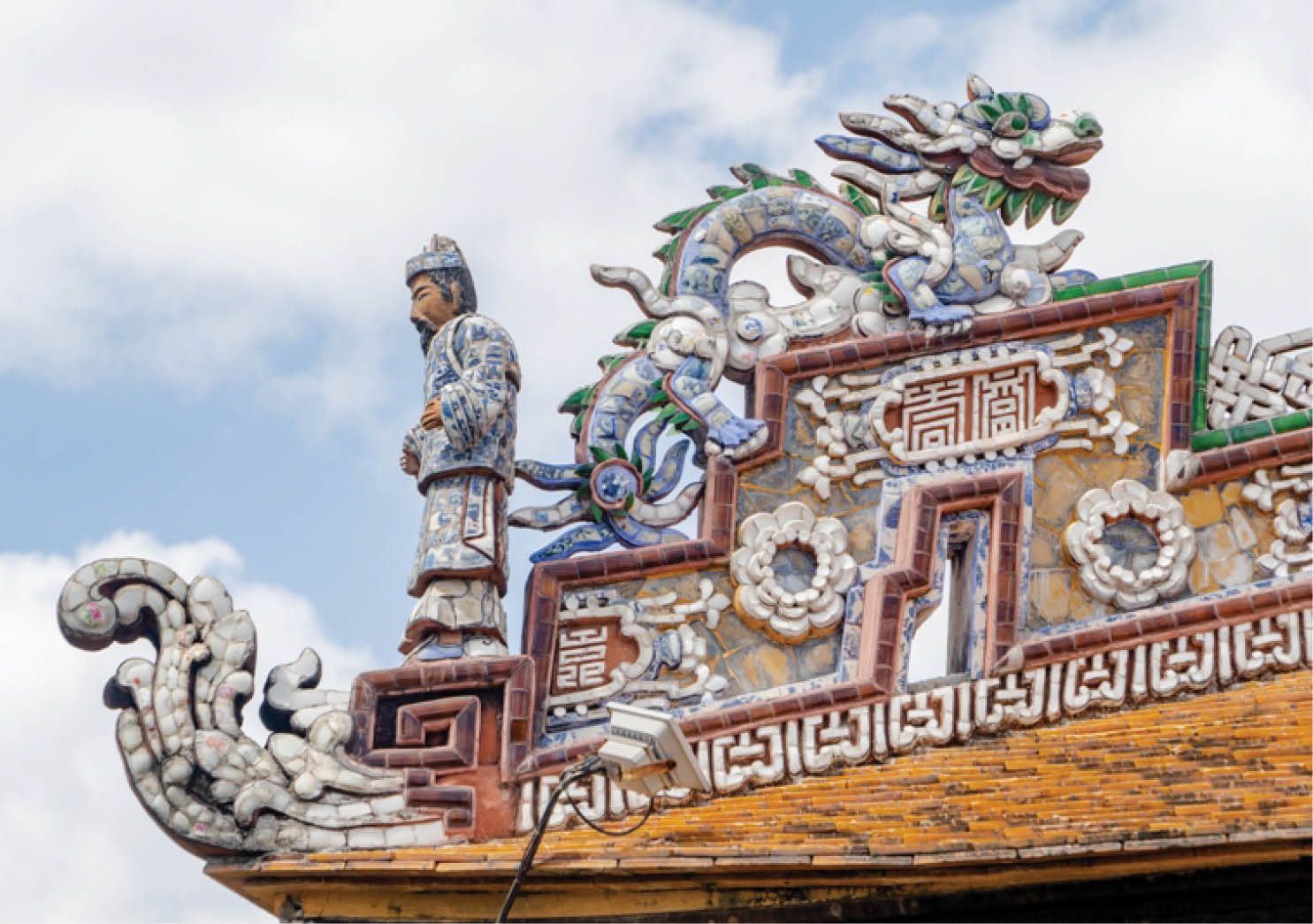With a very Vietnamese style
Ne hoa is a decorative form, using colors, mortar, pottery and porcelain, etc., for both exterior and interior designing. It can be found on almost all palaces and royal mausoleums of the Nguyen Dynasty. Thanks to golden hands of artisans, Chuong Duc Gate, Thai Binh Pavilion, Triple Gate at Hien Lam Pavilion, Royal Theatre, Trieu, The and Hung Temples, Truong Sanh, Dien Tho and An Dinh Residences, Minh Mang, Thieu Tri, Tu Duc and Khai Dinh Mausoleums, Le Thien Anh and Tu Du Tombs, etc., look luxurious and gorgeous.

Part of Thai Binh Pavilion
The art of painting on mortar has greatly developed in ancient Greece and Rome. Most of the palaces there were decorated with it. In Vietnam, this style first appeared in Hau-Le’s era, then developed leaps and bounds in late 19th century and early 20th century in the Nguyen’s era.
According to Assoc. Prof. Dr. Phan Thanh Binh, Rector of College of Arts, Hue University, our ancestors probably learned this art from China, but they made it become very Vietnamese. Through their works, artisans have successfully expressed their ability in fine arts at the time, which fully revealed the spiritual culture of an era.
Regarding themes, painting on mortar abides by the principle of grouping into sets such as: Four-Sacred-Animals, Four-Seasons, Eight-Sacred-Objects, Eight-Ferries, etc. Although those themes are Confucian in spirit, artisans have make them become very Vietnamese in a creative and autonomous way. According Assoc. Prof. Dr. Phan Thanh Binh, they are really works of great value. Although they were originally skillful workers from all over the country who had been summoned to the capital to work for the imperial court, artisans still kept their folklore qualities by stylizing vividly flowers, fruits, sacred animals and humans in diverse and accentuated colors, creating a gorgeous beauty full of light and evoking pleasure, delicacy and luxury. Each of their works is a symbol of their tenaciousness and deep aspiration for a beautiful life.

Human figures and dragons on the palace roof
Each work is a piece of art
Mr. Truong Van An, Director of Tam Tin Traditional Profession Company, agreed to meet us as soon as I asked him about painting on mortar. He is the son of Truong Van Lap, a typical artisan specializing in painting on mortar of the Nguyen Dynasty. He was titled Cuu Pham in 1936 by Emperor Bao Dai.
Mr. An said with pride that he belonged to the 9th generation of Truong Van family in Kim Bong (Quang Nam Province) whose ancestor had been summoned to Hue to design the imperial capital. His family boasts the three artisans who were titled: his great grandfather with That pham, his grandfather with Bat pham and his father with Cuu pham (That pham, Bat pham and Cuu pham were titles honored by the King.)
Following the traditional career of the family, Mr. An is now one of the talented artisans in painting on mortar and pottery mosaics in Hue. The difference is that while his ancestry worked on the royal constructions, he now works in the field of conservation and restoration. He admitted that beholding paintings on mortar at Khai Dinh Mausoleum or Thai Binh Pavilion, he sometimes felt overwhelmed. In front of those masterpieces, he feels he lacks many things, which urges him to keep on learning.
In his opinion, a good painting on mortar is one with sophisticated, accurate and well-colored patterns. In the past, his father taught him in a very visual way, hence easy to remember. For example, overall it must be “can thanh vien tho,” meaning meticulous and sharp when closely looked, but bold and strong from afar; in terms of patterns, “mai nhu khuyen tuc, truc nhu ke tuc,” meaning apricot blossom looks like dog footprints on sand while bamboo leaves must look like chicken footprints on sand or “tung chi thien, truc chi dia” meaning conifer leaves must look up while bamboo leaves look down. They are considered standards in painting on mortar in the old days.
Andrea Teufeul is a German expert in conservation. She loves Hue very much and has chosen Hue as her second home. She has assisted Hue in restoring and conserving many constructions such as Khai Tuong Pavilion (at An Dinh Residence), the Gate and the Screen at Tu Duc Mausoleum, Toi Linh Tu, Ta Vu, the Gate, the Screen and the Rockery at Phung Tien Palace in the Imperial City while training artisans working with mortar. She was the only foreigner who was awarded with Thua Thien-Hue Science and Technology Prize in 2018 for her research about developing and carrying out new methods in conserving and restoring constructions with painting on mortar.
About the artisans in painting on mortar in the old days, Andrea Teufeul said with admiration: “They had knowledge and techniques to be able to improvise while working. They employed the traditional art while creating new and diverse patterns so that each construction is an artwork.” With her love for Hue and for her job she added softly: “I hope those who have worked with me will apply properly the knowledge obtained to heritage conservation. They have to learn how to overcome the most difficult and challenging situations. This is a wonderful and worthwhile job, especially when we know well the completeness of a construction.”
In the Nguyen’s era, there was Ne Ngoa Tuong Cuc, the organization of masons who worked with bricks and tiles and were summoned to the imperial city to work. Literally “ne” means masonry; “ngoa” means bricks; “tuong cuc” is an organization of skillful artisans of a certain career.
According to Assoc. Prof. Dr. Phan Thanh Binh, ne hoa is painting on wet mortar. In Hue royal art, mortar is combined with other original materials such as pottery and porcelain, painted enamel, etc.
Story: Dong Van
Photos: Thanh Hoang